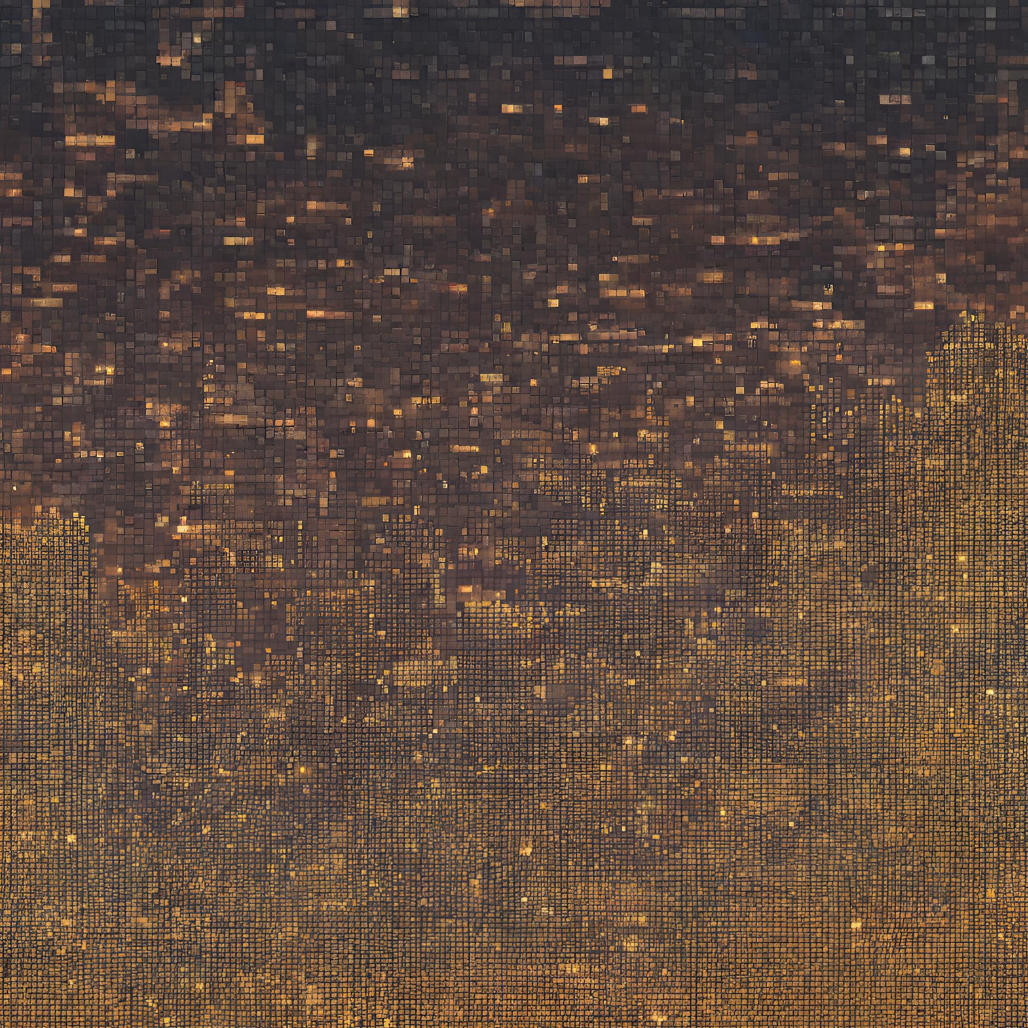Table of Links
4 Human Evaluations and Safety Testing, and 4.1 Prompts for Evaluation
5 Benchmark Evaluations and 5.1 Text
7 Conclusion, Acknowledgements, Contributors, and References
Appendix
B. Additional Information of Human Evaluations
7 Conclusion
In this paper, we introduced Chameleon, a new family of early-fusion token-based foundation models that set a new bar for multimodal machine learning. By learning a unified representation space over interleaved image and text tokens, Chameleon is a single model that achieves strong performance across a wide range of vision-language benchmarks while enabling new mixed-modal reasoning and generation capabilities.
The key to Chameleon’s success is its fully token-based architecture, which allows for seamless information integration across modalities. By quantizing images into discrete tokens and training on mixed-modal data from scratch, Chameleon learns to jointly reason over image and text in a way that is impossible with late-fusion architectures or models that maintain separate encoders for each modality. At the same time, Chameleon introduces novel techniques for stable and scalable training of early-fusion models, addressing key optimization and architectural design challenges that have previously limited the scale of such approaches. On tasks such as image captioning and visual question answering, Chameleon-34B outperforms models such as Flamingo and IDEFICS, while maintaining competitive performance on text-only benchmarks. Chameleon also unlocks entirely new possibilities for multimodal interaction, as demonstrated by its strong performance on our new benchmark for mixed-modal open-ended QA.
Acknowledgements
We thank Naren Briar for her invaluable contribution to manually curating safety prompts, which were crucial for our safety tuning efforts. We also thank Pierre Fernandez for his indispensable support with the Chameleon release, Shelly Sheynin for her work on the Chameleon image tokenizer, Puxin Xu and David for helping us with datasets. Additionally, we thank Mitchell Wortsman for engaging in insightful discussions about stability in large-scale language models and Mike Lewis for general discussions and advice throughout the project. We thank Aaron Grattafiori, Firat Ozgenel, Divya Shah, Danny Livshits, Cristian Canton Ferrer, Saghar Hosseini, Ramon Calderer, Joshua Saxe, Daniel Song and Manish Bhatt for their help with the safety and red teaming efforts.
Contributors
We attribute credit separated by bucket of work. Additionally, ∗ indicates joint first authors, † indicates key contributors, ‡ indicates workstream leads, and ♯ indicates project leads.
Pre-Training: Srinivasan Iyer∗ , Bernie Huang∗ , Lili Yu† , Arun Babu† , Chunting Zhou† , Kushal Tirumala, Xi Victoria Lin, Hu Xu, Xian Li, Akshat Shrivastava, Omer Levy‡ , Armen Aghajanyan∗‡
Alignment and Safety: Ram Pasunuru∗ , Andrew Cohen† , Aram H. Markosyan† , Koustuv Sinha† , Xiaoqing Ellen Tan† , Ivan Evtimov, Ping Yu, Tianlu Wang, Olga Golovneva, Asli Celikyilmaz‡
Inference and Evaluation: Pedro Rodriguez† , Leonid Shamis† , Vasu Sharma† , Christine Jou, Karthik Padthe† , Ching-Feng Yeh, Mingda Chen, Bapi Akula, Jacob Kahn‡ , Daniel Li‡ , Scott Yih‡
Overall Project: Barlas Oguz, Morteza Behrooz, Benjamin Muller, Carleigh Wood, Mary Williamson, Ramya Raghavendra, Barbara Usher, William Ngan, Nikolay Bashlykov, Lukas Blecher, Sony Theakanath (Lead PM), Ammar Rizvi (Lead TPM), Gargi Ghosh♯ , Luke Zettlemoyer♯
References
Armen Aghajanyan, Bernie Huang, Candace Ross, Vladimir Karpukhin, Hu Xu, Naman Goyal, Dmytro Okhonko, Mandar Joshi, Gargi Ghosh, Mike Lewis, et al. Cm3: A causal masked multimodal model of the internet. arXiv preprint arXiv:2201.07520, 2022.
Armen Aghajanyan, Lili Yu, Alexis Conneau, Wei-Ning Hsu, Karen Hambardzumyan, Susan Zhang, Stephen Roller, Naman Goyal, Omer Levy, and Luke Zettlemoyer. Scaling laws for generative mixed-modal language models. arXiv preprint arXiv:2301.03728, 2023.
Agriflanders. Miniatuurpaardjes prijskamp - Agriflanders 2009, 2009. https://en.wikipedia.org/wiki/File: Miniatuurpaardje.jpg. CC-BY-SA 2.0, https://creativecommons.org/licenses/by/2.0/deed.en.
Jean-Baptiste Alayrac, Jeff Donahue, Pauline Luc, Antoine Miech, Iain Barr, Yana Hasson, Karel Lenc, Arthur Mensch, Katherine Millican, Malcolm Reynolds, et al. Flamingo: a visual language model for few-shot learning. Advances in Neural Information Processing Systems, 35:23716–23736, 2022.
Tadas Baltrušaitis, Chaitanya Ahuja, and Louis-Philippe Morency. Multimodal machine learning: A survey and taxonomy. IEEE transactions on pattern analysis and machine intelligence, 41(2):423–443, 2018.
Hangbo Bao, Li Dong, Songhao Piao, and Furu Wei. Beit: Bert pre-training of image transformers. arXiv preprint arXiv:2106.08254, 2021.
James Betker, Gabriel Goh, Li Jing, Tim Brooks, Jianfeng Wang, Linjie Li, Long Ouyang, Juntang Zhuang, Joyce Lee, Yufei Guo, et al. Improving image generation with better captions. Computer Science. https://cdn. openai. com/papers/dall-e-3. pdf, 2(3):8, 2023.
Yonatan Bisk, Rowan Zellers, Jianfeng Gao, Yejin Choi, et al. Piqa: Reasoning about physical commonsense in natural language. In Proceedings of the AAAI conference on artificial intelligence, pages 7432–7439, 2020.
Jun Chen, Han Guo, Kai Yi, Boyang Li, and Mohamed Elhoseiny. Visualgpt: Data-efficient adaptation of pretrained language models for image captioning. In Proceedings of the IEEE/CVF Conference on Computer Vision and Pattern Recognition, pages 18030–18040, 2022.
Xinlei Chen, Hao Fang, Tsung-Yi Lin, and Ramakrishna Vedantam. https://github.com/salaniz/pycocoevalcap, 2020.
Aakanksha Chowdhery, Sharan Narang, Jacob Devlin, Maarten Bosma, Gaurav Mishra, Adam Roberts, Paul Barham, Hyung Won Chung, Charles Sutton, Sebastian Gehrmann, et al. PaLM: Scaling language modeling with pathways. arXiv preprint arXiv:2204.02311, 2022.
Christopher Clark, Kenton Lee, Ming-Wei Chang, Tom Kwiatkowski, Michael Collins, and Kristina Toutanova. Boolq: Exploring the surprising difficulty of natural yes/no questions. arXiv preprint arXiv:1905.10044, 2019.
Peter Clark, Isaac Cowhey, Oren Etzioni, Tushar Khot, Ashish Sabharwal, Carissa Schoenick, and Oyvind Tafjord. Think you have solved question answering? try arc, the ai2 reasoning challenge. arXiv preprint arXiv:1803.05457, 2018.
Karl Cobbe, Vineet Kosaraju, Mohammad Bavarian, Mark Chen, Heewoo Jun, Lukasz Kaiser, Matthias Plappert, Jerry Tworek, Jacob Hilton, Reiichiro Nakano, et al. Training verifiers to solve math word problems. arXiv preprint arXiv:2110.14168, 2021.
Mostafa Dehghani, Josip Djolonga, Basil Mustafa, Piotr Padlewski, Jonathan Heek, Justin Gilmer, Andreas Peter Steiner, Mathilde Caron, Robert Geirhos, Ibrahim Alabdulmohsin, et al. Scaling vision transformers to 22 billion parameters. In International Conference on Machine Learning, pages 7480–7512. PMLR, 2023.
Oran Gafni, Adam Polyak, Oron Ashual, Shelly Sheynin, Devi Parikh, and Yaniv Taigman. Make-a-scene: Scene-based text-to-image generation with human priors. arXiv preprint arXiv:2203.13131, 2022.
Gemini, Rohan Anil, Sebastian Borgeaud, Yonghui Wu, Jean-Baptiste Alayrac, Jiahui Yu, Radu Soricut, Johan Schalkwyk, Andrew M Dai, Anja Hauth, et al. Gemini: a family of highly capable multimodal models. arXiv preprint arXiv:2312.11805, 2023.
Yash Goyal, Tejas Khot, Douglas Summers-Stay, Dhruv Batra, and Devi Parikh. Making the V in VQA matter: Elevating the role of image understanding in visual question answering. In Proceedings of the IEEE conference on computer vision and pattern recognition, pages 6904–6913, 2017.
Dan Hendrycks, Collin Burns, Steven Basart, Andy Zou, Mantas Mazeika, Dawn Song, and Jacob Steinhardt. Measuring massive multitask language understanding. In International Conference on Learning Representations, 2020.
Dan Hendrycks, Collin Burns, Saurav Kadavath, Akul Arora, Steven Basart, Eric Tang, Dawn Song, and Jacob Steinhardt. Measuring mathematical problem solving with the math dataset. arXiv preprint arXiv:2103.03874, 2021.
Or Honovich, Thomas Scialom, Omer Levy, and Timo Schick. Unnatural instructions: Tuning language models with (almost) no human labor, 2022.
Drew A Hudson and Christopher D Manning. Gqa: A new dataset for real-world visual reasoning and compositional question answering. In Proceedings of the IEEE/CVF conference on computer vision and pattern recognition, pages 6700–6709, 2019.
Andrew Jaegle, Sebastian Borgeaud, Jean-Baptiste Alayrac, Carl Doersch, Catalin Ionescu, David Ding, Skanda Koppula, Daniel Zoran, Andrew Brock, Evan Shelhamer, et al. Perceiver io: A general architecture for structured inputs & outputs. arXiv preprint arXiv:2107.14795, 2021.
Albert Q Jiang, Alexandre Sablayrolles, Arthur Mensch, Chris Bamford, Devendra Singh Chaplot, Diego de las Casas, Florian Bressand, Gianna Lengyel, Guillaume Lample, Lucile Saulnier, et al. Mistral 7b. arXiv preprint arXiv:2310.06825, 2023.
Albert Q Jiang, Alexandre Sablayrolles, Antoine Roux, Arthur Mensch, Blanche Savary, Chris Bamford, Devendra Singh Chaplot, Diego de las Casas, Emma Bou Hanna, Florian Bressand, et al. Mixtral of experts. arXiv preprint arXiv:2401.04088, 2024.
Yang Jin, Kun Xu, Liwei Chen, Chao Liao, Jianchao Tan, Bin Chen, Chenyi Lei, An Liu, Chengru Song, Xiaoqiang Lei, et al. Unified language-vision pretraining with dynamic discrete visual tokenization. arXiv preprint arXiv:2309.04669, 2023.
Yuval Kirstain, Adam Polyak, Uriel Singer, Shahbuland Matiana, Joe Penna, and Omer Levy. Pick-a-pic: An open dataset of user preferences for text-to-image generation, 2023.
Klaus Krippendorff. Content analysis: An introduction to its methodology. Sage publications, 2018.
Taku Kudo and John Richardson. Sentencepiece: A simple and language independent subword tokenizer and detokenizer for neural text processing. arXiv preprint arXiv:1808.06226, 2018.
Hugo Laurençon, Lucile Saulnier, Léo Tronchon, Stas Bekman, Amanpreet Singh, Anton Lozhkov, Thomas Wang, Siddharth Karamcheti, Alexander M Rush, Douwe Kiela, et al. Obelisc: An open web-scale filtered dataset of interleaved image-text documents. arXiv preprint arXiv:2306.16527, 2023.
Kevin Lee and Shubho Sengupta. Introducing the ai research supercluster — meta’s cutting-edge ai supercomputer for ai research. https://ai.facebook.com/blog/ai-rsc/, 2022.
Benjamin Lefaudeux, Francisco Massa, Diana Liskovich, Wenhan Xiong, Vittorio Caggiano, Sean Naren, Min Xu, Jieru Hu, Marta Tintore, Susan Zhang, Patrick Labatut, Daniel Haziza, Luca Wehrstedt, Jeremy Reizenstein, and Grigory Sizov. xformers: A modular and hackable transformer modelling library. https://github.com/facebookresearch/ xformers, 2022.
Tsung-Yi Lin, Michael Maire, Serge Belongie, James Hays, Pietro Perona, Deva Ramanan, Piotr Dollár, and C Lawrence Zitnick. Microsoft coco: Common objects in context. In European conference on computer vision, pages 740–755. Springer, 2014.
Haotian Liu, Chunyuan Li, Yuheng Li, and Yong Jae Lee. Improved baselines with visual instruction tuning. arXiv preprint arXiv:2310.03744, 2023a.
Haotian Liu, Chunyuan Li, Qingyang Wu, and Yong Jae Lee. Visual instruction tuning. arXiv preprint arXiv:2304.08485, 2023b.
Ze Liu, Yutong Lin, Yue Cao, Han Hu, Yixuan Wei, Zheng Zhang, Stephen Lin, and Baining Guo. Swin transformer: Hierarchical vision transformer using shifted windows. In Proceedings of the IEEE/CVF international conference on computer vision, pages 10012–10022, 2021.
Ilya Loshchilov and Frank Hutter. Decoupled weight decay regularization. arXiv preprint arXiv:1711.05101, 2017.
Giacomo Marzi, Marco Balzano, and Davide Marchiori. K-alpha calculator–krippendorff’s alpha calculator: A userfriendly tool for computing krippendorff’s alpha inter-rater reliability coefficient. MethodsX, 12:102545, 2024. ISSN 2215-0161. doi: https://doi.org/10.1016/j.mex.2023.102545. https://www.sciencedirect.com/science/article/pii/ S2215016123005411.
Todor Mihaylov, Peter Clark, Tushar Khot, and Ashish Sabharwal. Can a suit of armor conduct electricity? a new dataset for open book question answering. arXiv preprint arXiv:1809.02789, 2018.
OpenAI. GPTV System Card. https://cdn.openai.com/papers/GPTV_System_Card.pdf, 2023.
Adam Paszke, Sam Gross, Francisco Massa, Adam Lerer, James Bradbury, Gregory Chanan, Trevor Killeen, Zeming Lin, Natalia Gimelshein, Luca Antiga, et al. PyTorch: An imperative style, high-performance deep learning library. In NeurIPS, 2019.
Bryan A Plummer, Liwei Wang, Chris M Cervantes, Juan C Caicedo, Julia Hockenmaier, and Svetlana Lazebnik. Flickr30k entities: Collecting region-to-phrase correspondences for richer image-to-sentence models. In Proceedings of the IEEE international conference on computer vision, pages 2641–2649, 2015.
Aditya Ramesh, Mikhail Pavlov, Gabriel Goh, Scott Gray, Chelsea Voss, Alec Radford, Mark Chen, and Ilya Sutskever. Zero-shot text-to-image generation. arXiv preprint arXiv:2102.12092, 2021.
Aditya Ramesh, Prafulla Dhariwal, Alex Nichol, Casey Chu, and Mark Chen. Hierarchical text-conditional image generation with clip latents. arXiv preprint arXiv:2204.06125, 2022.
Baptiste Roziere, Jonas Gehring, Fabian Gloeckle, Sten Sootla, Itai Gat, Xiaoqing Ellen Tan, Yossi Adi, Jingyu Liu, Tal Remez, Jérémy Rapin, et al. Code llama: Open foundation models for code. arXiv preprint arXiv:2308.12950, 2023.
Keisuke Sakaguchi, Ronan Le Bras, Chandra Bhagavatula, and Yejin Choi. Winogrande: An adversarial winograd schema challenge at scale. Communications of the ACM, 64(9):99–106, 2021.
Mikayel Samvelyan, Sharath Chandra Raparthy, Andrei Lupu, Eric Hambro, Aram H. Markosyan, Manish Bhatt, Yuning Mao, Minqi Jiang, Jack Parker-Holder, Jakob Foerster, Tim Rocktäschel, and Roberta Raileanu. Rainbow teaming: Open-ended generation of diverse adversarial prompts, 2024.
Maarten Sap, Hannah Rashkin, Derek Chen, Ronan LeBras, and Yejin Choi. Socialiqa: Commonsense reasoning about social interactions. arXiv preprint arXiv:1904.09728, 2019.
Rylan Schaeffer. Pretraining on the test set is all you need. arXiv preprint arXiv:2309.08632, 2023.
Christoph Schuhmann, Romain Beaumont, Richard Vencu, Cade Gordon, Ross Wightman, Mehdi Cherti, Theo Coombes, Aarush Katta, Clayton Mullis, Mitchell Wortsman, et al. Laion-5b: An open large-scale dataset for training next generation image-text models. arXiv preprint arXiv:2210.08402, 2022.
Georges Seguin. Mille-feuille, 2010. https://en.wikipedia.org/wiki/File:Mille-feuille_20100916.jpg. CC-BY-SA 3.0, https://creativecommons.org/licenses/by-sa/3.0/deed.en.
Rico Sennrich, Barry Haddow, and Alexandra Birch. Neural machine translation of rare words with subword units. In ACL, Berlin, Germany, 2016. https://aclanthology.org/P16-1162.
ShareGPT. GPTV System Card. https://sharegpt.com/, 2023.
Noam Shazeer. Glu variants improve transformer. arXiv preprint arXiv:2002.05202, 2020.
Maksim Sokolov. Sagrada Familia July 2022, 2022. https://en.wikipedia.org/wiki/File:Sagrada_Familia_%28July_ 2022%29_08.jpg. CC-BY-SA-4.0, https://creativecommons.org/licenses/by-sa/4.0/deed.en.
Nitish Srivastava, Geoffrey Hinton, Alex Krizhevsky, Ilya Sutskever, and Ruslan Salakhutdinov. Dropout: a simple way to prevent neural networks from overfitting. The journal of machine learning research, 15(1):1929–1958, 2014.
Jianlin Su, Yu Lu, Shengfeng Pan, Ahmed Murtadha, Bo Wen, and Yunfeng Liu. Roformer: Enhanced transformer with rotary position embedding. arxiv e-prints, art. arXiv preprint arXiv:2104.09864, 2021.
Hugo Touvron, Louis Martin, Kevin Stone, Peter Albert, Amjad Almahairi, Yasmine Babaei, Nikolay Bashlykov, Soumya Batra, Prajjwal Bhargava, Shruti Bhosale, et al. Llama 2: Open foundation and fine-tuned chat models. arXiv preprint arXiv:2307.09288, 2023.
Jarek Tuszyński. American toad (Bufo americanus) found in Fairfax, Virginia, 2015. https://en.wikipedia.org/wiki/File: Miniatuurpaardje.jpg. CC-BY-SA-4.0, https://creativecommons.org/licenses/by-sa/4.0/deed.en.
Ramakrishna Vedantam, C Lawrence Zitnick, and Devi Parikh. Cider: Consensus-based image description evaluation. In Proceedings of the IEEE conference on computer vision and pattern recognition, pages 4566–4575, 2015.
Mitchell Wortsman, Peter J Liu, Lechao Xiao, Katie Everett, Alex Alemi, Ben Adlam, John D Co-Reyes, Izzeddin Gur, Abhishek Kumar, Roman Novak, et al. Small-scale proxies for large-scale transformer training instabilities. arXiv preprint arXiv:2309.14322, 2023.
Lili Yu, Bowen Shi, Ramakanth Pasunuru, Benjamin Muller, Olga Golovneva, Tianlu Wang, Arun Babu, Binh Tang, Brian Karrer, Shelly Sheynin, et al. Scaling autoregressive multi-modal models: Pretraining and instruction tuning. arXiv preprint arXiv:2309.02591, 2023.
Rowan Zellers, Ari Holtzman, Yonatan Bisk, Ali Farhadi, and Yejin Choi. Hellaswag: Can a machine really finish your sentence? arXiv preprint arXiv:1905.07830, 2019.
Biao Zhang and Rico Sennrich. Root mean square layer normalization. Advances in Neural Information Processing Systems, 32, 2019.
Chunting Zhou, Pengfei Liu, Puxin Xu, Srini Iyer, Jiao Sun, Yuning Mao, Xuezhe Ma, Avia Efrat, Ping Yu, Lili Yu, et al. Lima: Less is more for alignment. arXiv preprint arXiv:2305.11206, 2023.
A Samples
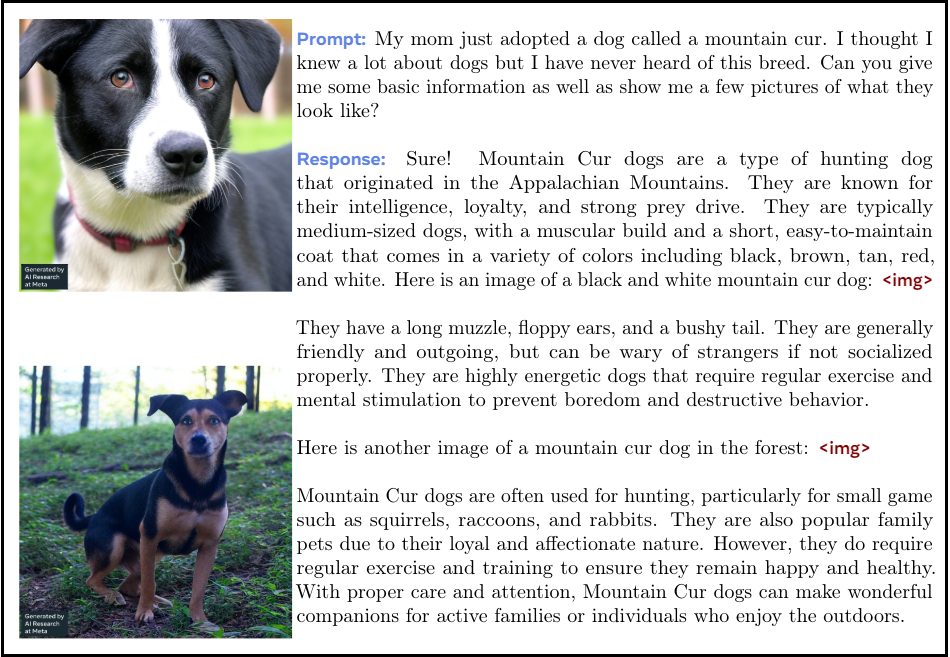


B Additional Information of Human Evaluations

For the twelve task categories of the prompts we collected for human evaluation, a short description of each category can be found in Table 8.
The task fulfillment rates, broken down by each task category and modality are shown in Table 9 and Table 10.
Chameleon’s win rates, broken down by task category and modality, are shown in Table 11, Table 12, Table 13 and Table 14.


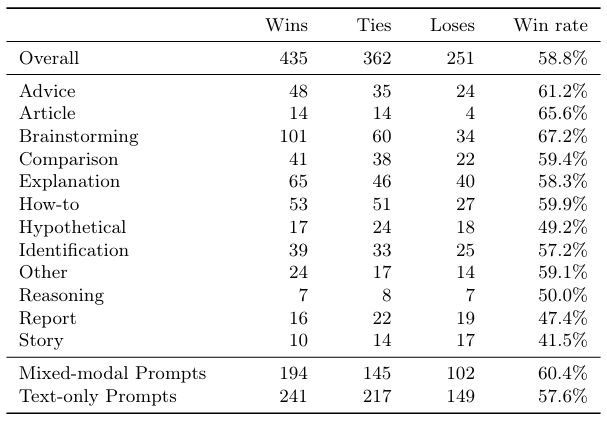
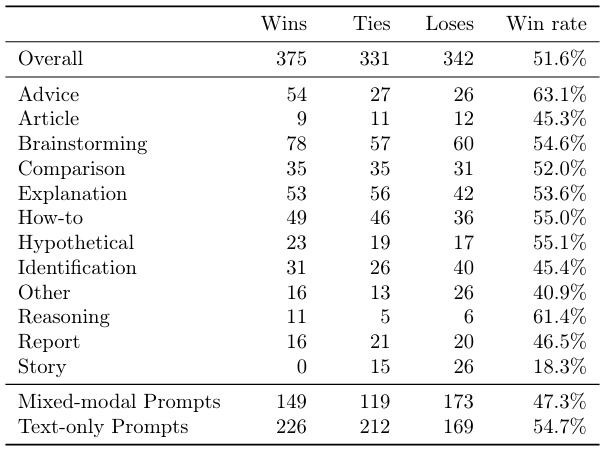

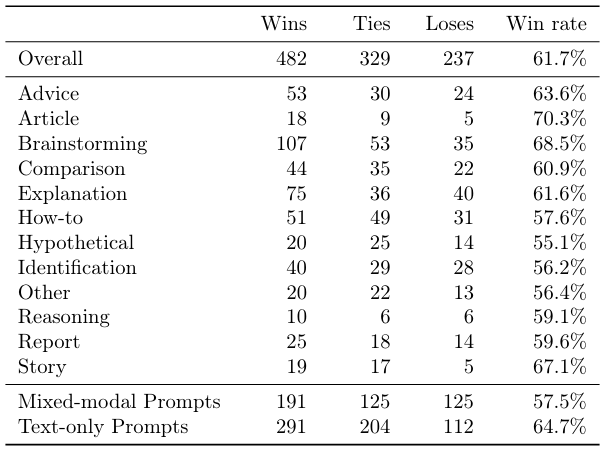
Author:
(1) Chameleon Team, FAIR at Meta.
This paper is
